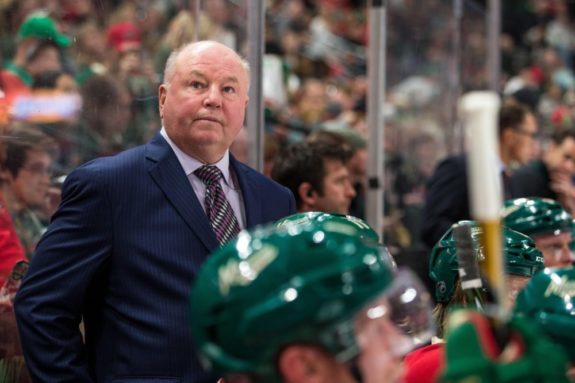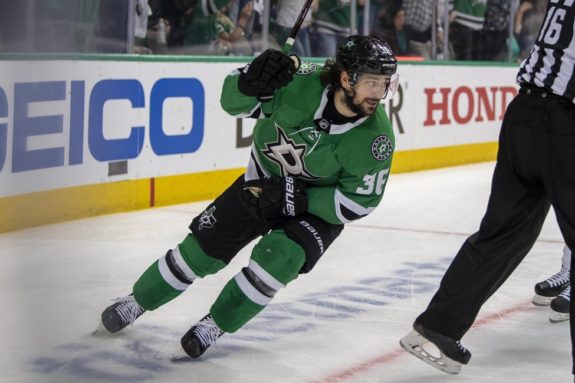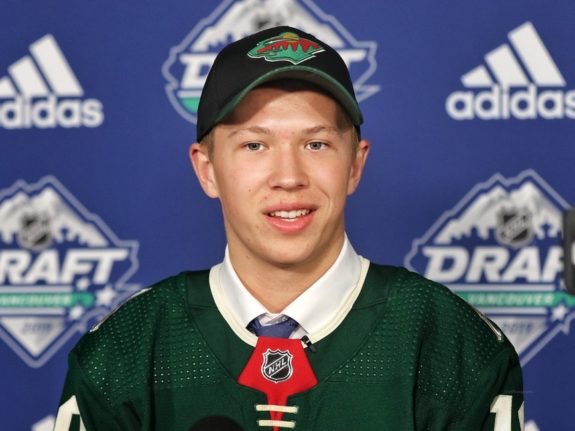When the Minnesota Wild tossed around the cash in 2012 to sign home state talent Zach Parise from the New Jersey Devils to a monster 13-year deal, they needed a big time face for the organization. Fellow free agent and Nashville Predator Ryan Suter would follow Parise to Minnesota on an identical contract that very same summer. In all the campaigns since, the faces of those two men led the Wild into the playoffs with varying degrees of success. Having never reached the conference finals, the Wild’s streak of playoff entrances ended with last year’s dismal finish. With the new season approaching rapidly, can a “retool” and not a “rebuild” be effective for the future progression of the Wild?
Bruce’s Fit for the Future?
A coach with the resumé, albeit with some disappointments as well, that Bruce Boudreau has should have the chance to overcome a hard season after the previous two were filled with such tremendous hope and progression. Having finished second in the Central Division in 2016-17, his first season, the team fell to pieces against the St. Louis Blues in the first round of those playoffs.

The shock of such an ousting didn’t seem to ebb into the succeeding campaign, with another strong regular season in 2017-18. Another devastating first round crushing, however, this time by the Winnipeg Jets, would end the Wild’s Stanley Cup ambitions once more. The hangover from that second straight playoff spanking was too much for the team as constructed at the time, and poor play in 2018-19 led to trades and future speculation on the status of many fan favorites as well as the coach himself. Should he stumble out of the gate in his fourth season, he could find himself out of a job while a fresh face behind the bench would get a crack at solidifying a roster that has talent from top to bottom.
The Veteran Presence
With foundational players like Parise, Suter, Mikko Koivu and Eric Staal still in the ranks, the Wild are not without fire or star power going into the new season. While the aforementioned are all in their mid-30s, their statistics were those of still effective hockey players. Experienced youth like Jason Zucker also demonstrates the club’s potential with a few further tweaks. The youth garnered between the last two drafts, and the bounty received in the trades of Mikael Granlund, Nino Niederreiter and Charlie Coyle create further depth for those vets to work with. The signing of Mats Zuccarello seemed contradictory for a club coming off of the worst season in nearly a decade, but don’t be too sure.

The best hockey teams have talent, veteran leadership and depth alongside tenacious youth and passion. This is effective in that the experience guides the youth at a quicker pace than would be achieved were they allowed to flounder amongst only themselves. Additionally, the youth acts as motivation, and an almost tangible passion of which can always remind an older player just exactly how much competing and playing together means. As many professionals become jaded through years of experience, youthful passion, wisdom, and engagement can be as important as the guiding hand of experience to the youth themselves.
The Youth Movement
As mentioned before, the trade compensations and prior two drafts have left Minnesota in a position where young players can step up and make an impact alongside the Wild’s core. Center/left winger Ryan Donato (acquired in the Coyle trade), center/right winger Victor Rask (Niederreiter) and left winger Kevin Fiala (Granlund) are all younger, and present different practical upsides in creating lines mixed with experience and youth for the team. Alongside top picks like defenseman Filip Johansson in the 2018 first round and center/left winger Matthew Boldy in the 2019 first round, this youth and age can coagulate into a proper four line rotation featuring the combination of youth and experience in regards to both sides of the puck.
Luke Kunin’s torn ACL the day after the Wild dropped forward Chris Stewart to accommodate his salary is a blow for this season, while players like Jordan Greenway and Joel Eriksson Ek, young and talented, will have to step up and shine brighter as a result. With the proper mixture of youth and experience per line, great team strides could be made despite the Kunin setback.

A “State of Hockey”
While some believe that such a precipitous dive in the standings last season warrants an entire team’s demolition, it is difficult to reconcile this against the backdrop of sustained play for six seasons and of the team’s environment. The “State of Hockey,” as it is known, could not and would not bear a “trust the process” type scenario in which losing is an expectation for the future acquisition of greater talent. There is something too defeatist, and almost a sense of cheapness in doing so; to never be totally atrocious on one’s ascension to peak performance or results can be as important to a fanbase or organization as the ascension itself.
Can the Wild bounce back from a down year? Absolutely, examples of this can be seen across the world of hockey as recent as the 2019 Stanley Cup champions. The Blues won the cup by overcoming years of varying success, including a terrible record this very season, that saw them in last place after Jan. 1 and with less experience than previous team incarnations had possessed. It is not impossible nor very improbable that the Wild could demonstrate this in the upcoming NHL season. To do so, however, it will take the trust of the coach, rookies, youth and veterans alike. It will take the coagulation of insight and vision, exciting talent and physicality alongside haggard, battle-tested experience.